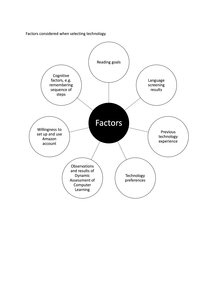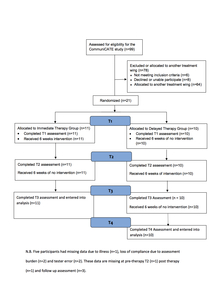Technology-Enhanced Reading Therapy for People With Aphasia: Findings From a Quasirandomized Waitlist Controlled Study.
Caute, A., Woolf, C., Wilson, S.  ORCID: 0000-0001-6445-654X , Stokes, C., Monnelly, K., Cruice, M.
ORCID: 0000-0001-6445-654X , Stokes, C., Monnelly, K., Cruice, M.  ORCID: 0000-0001-7344-2262, Bacon, K. & Marshall, J.
ORCID: 0000-0001-7344-2262, Bacon, K. & Marshall, J.  ORCID: 0000-0002-6589-221X (2019).
Technology-Enhanced Reading Therapy for People With Aphasia: Findings From a Quasirandomized Waitlist Controlled Study..
Journal of Speech, Language, and Hearing Research, 62(12),
pp. 4382-4416.
doi: 10.1044/2019_jslhr-l-18-0484
ORCID: 0000-0002-6589-221X (2019).
Technology-Enhanced Reading Therapy for People With Aphasia: Findings From a Quasirandomized Waitlist Controlled Study..
Journal of Speech, Language, and Hearing Research, 62(12),
pp. 4382-4416.
doi: 10.1044/2019_jslhr-l-18-0484
Abstract
Purpose This study investigated the effects of technology-enhanced reading therapy for people with reading impairments, using mainstream assistive reading technologies alongside reading strategies. Method The study used a quasirandomized waitlist controlled design. Twenty-one people with reading impairments following stroke were randomly assigned to receive 14 hr of therapy immediately or after a 6-week delay. During therapy, participants were trained to use assistive reading technology that offered a range of features to support reading comprehension. They developed skills in using the technology independently and in applying the technology to their personal reading goals. The primary outcome measure assessed reading comprehension, using Gray Oral Reading Test-Fourth Edition (GORT-4). Secondary measures were as follows: Reading Comprehension Battery for Aphasia-Second Edition, Reading Confidence and Emotions Questionnaire, Communication Activities of Daily Living-Second Edition, Visual Analog Mood Scales, and Assessment of Living With Aphasia. Matched texts were used with the GORT-4 to compare technology-assisted and unassisted reading comprehension. Mixed analyses of variance explored change between T1 and T2, when the immediate group had received therapy but the delayed group had not, thus serving as untreated controls. Pretherapy, posttherapy, and follow-up scores on the measures were also examined for all participants. Results GORT-4 results indicated that the immediately treated group improved significantly in technology-assisted reading following therapy, but not in unassisted reading. However, the data were not normally distributed, and secondary nonparametric analysis was not significant. The control group was unstable over the baseline, improving significantly in unassisted reading. The whole-group analysis showed significant gains in assisted (but not unassisted) reading after therapy that were maintained at follow-up. The Reading Confidence and Emotions Questionnaire results improved significantly following therapy, with good maintenance of change. Results on all other secondary measures were not significant. Conclusions Technology-assisted reading comprehension improved following the intervention, with treatment compensating for, rather than remediating, the reading impairment. Participants' confidence and emotions associated with reading also improved. Gains were achieved after 14 therapy sessions, using assistive technologies that are widely available and relatively affordable, meaning that this approach could be implemented in clinical practice.
| Publication Type: | Article |
|---|---|
| Additional Information: | Copyright © 2019 American Speech-Language-Hearing Association |
| Subjects: | P Language and Literature > P Philology. Linguistics R Medicine |
| Departments: | School of Health & Medical Sciences > Department of Allied Health |
| SWORD Depositor: |
Download (380kB) | Preview
![Figure 1 [thumbnail of Figure 1]](https://openaccess.city.ac.uk/23328/1.hassmallThumbnailVersion/Figure%201%20Tech%20enhanced%20reading%20therapy.jpg)

Download (984kB) | Preview
![Figure 2 [thumbnail of Figure 2]](https://openaccess.city.ac.uk/23328/8.hassmallThumbnailVersion/Figure%202%20Tech%20Enhanced%20Reading%20Therapy.jpg)

Download (770kB) | Preview
Download (75kB) | Preview
Download (76kB) | Preview
Export
Downloads
Downloads per month over past year


 Metadata
Metadata Metadata
Metadata